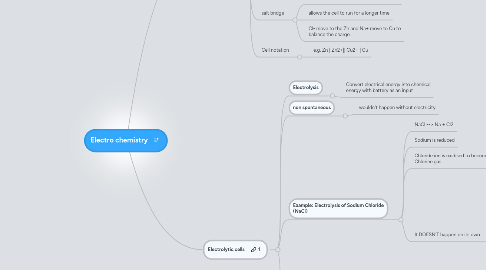
1. Voltaic cells
1.1. spontaneous reaction where electrons move from one atom to another
1.2. the anode is where oxidation occurs
1.3. the cathode is where reduction occurs
1.4. the movement of electrons from the anode to the cathode produces electricity
1.5. one side of the wire has a metal with a weaker pull on electrons (eg. Zn)
1.5.1. the other side has a metal with a stronger pull on electrons (eg. Cu)
1.5.2. as the electrons move from the Zn to Cu, the Zn2+ ions form that dissolve in the solution, the Zn metal grows smaller.
1.5.3. on the other side, Cu2+ in the solution takes the electrons to form Cu atoms that make the Cu bigger
1.6. salt bridge
1.6.1. helps balance charge as positive/negative charge builds up on either side
1.6.2. allows the cell to run for a longer time
1.6.3. Cl- move to the Zn and Na+ move to Cu to balance the charge.
1.7. Cell notation
1.7.1. e.g. Zn | Zn2+|| Cu2+ | Cu
2. Electrolytic cells
2.1. Electrolysis
2.1.1. Convert electrical energy into chemical energy with battery as an input
2.2. non spontaneous
2.2.1. wouldn't happen without electricity
2.3. Example: Electrolysis of Sodium Chloride (NaCl)
2.3.1. NaCl --> Na + Cl2
2.3.2. Sodium is reduced
2.3.3. Chloride ion is oxidised to become Chlorine gas
2.3.4. It DOESN'T happen on its own
2.3.4.1. process is forced by electricity (from battery)
2.3.4.1.1. Battery is attached to an electrode
2.3.4.1.2. NaCl has to be molten for electrolysis to happen
2.3.4.2. Positive (pull electrons)
2.3.4.2.1. Oxidation happens for Chloride
2.3.4.2.2. 2Cl^- --> Cl2 + 2e^-
2.3.4.3. Anode
2.3.4.4. Negative (push electrons)
2.3.4.4.1. The Cathode
2.3.4.4.2. Reduction for Sodium
2.3.4.4.3. Na^+ +e^- --> Na
2.4. Determining the products in electrolytic cells
2.4.1. Step 1: Identify all the ions present in the electrolyte. As in the anode and cathode.
2.4.2. Step 2 : Write the half-equation for the reaction at each electrode, showing electrons released at the anode in oxidation and taken up at the cathode in reduction.
2.4.3. Step 3 :Balance the electrons lost and gained at the anode and the cathode, then add the two half-equations to write the equation for the net reaction.
2.4.4. Step 4: Consider what changes would be observed in the cell as a result of the redox processes occurring.
